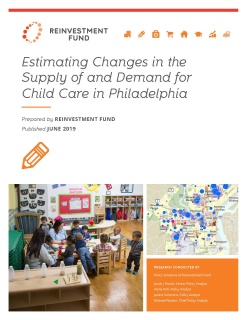Estimating Changes in the Supply of and Demand for Child Care in Philadelphia (2017)
In 2014, Reinvestment Fund conducted an initial analysis of the supply of and demand for child care in Philadelphia to identify areas of the city where targeted investments could help address shortages of high-quality child care. Now updated to reflect the year 2017, Reinvestment Fund’s latest childcare analysis provides updated estimates to track the change over time in the supply of, demand for, and shortages in child care.
Reinvestment Fund’s Childcare Map is an interactive online tool that makes the results of this work accessible to the public at no cost. The tool identifies neighborhoods where high-quality child care is scarce in absolute and relative terms, while also providing actionable information for funders, practitioners, and childcare advocates.
This report presents the results of descriptive and spatial analyses of the child care landscape in Philadelphia in 2017. It details both short- and long-term changes in the supply of, demand for, and gaps in care; the year-to-year changes from 2016 to 2017, as well as shifts since the first analyses were conducted in 2014.
It is important to note that various factors could contribute to the observed changes. For example, demographic shifts can affect demand, operation cost can affect supply, and new policy initiatives and investments can directly impact gaps. To this last point, this analysis also presents the location of strategic investments made in facilities in high-gap areas through the Fund for Quality (FFQ). Subsequent updates to the childcare analysis will be conducted to assess the impact of FFQ investments on gaps between supply and demand for child care in the years ahead.




